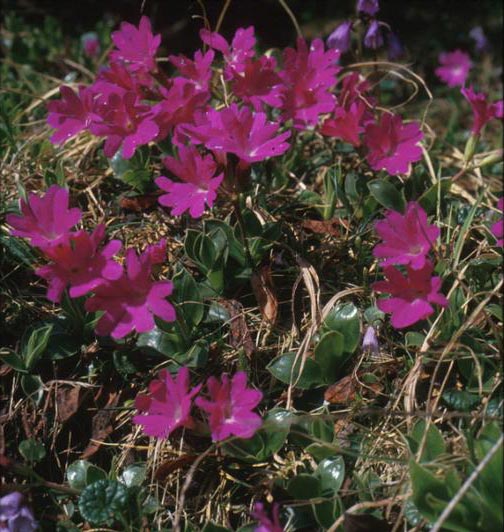Extinction of Alpine Plants May Remain Undetectable for a Long Time

Primula clusiana on Mount Hochschwab in the Austrian alps. (Photo: ©Stefan Dullinger)
For alpine plant species, climate change presents a special challenge: To escape increased greenhouse warming, the species have to move to a higher-altitude habitat. Due to the pyramidal structure of mountains, however, little surface area is available for this endeavor. To estimate the extinction risk of these plants, scientists have previously resorted to static models that insufficiently mapped the dynamic responses of flora to climate change.
More reliable predictions
Now, the team of Frédéric Guillaume of the Department of Evolutionary Biology and Environmental Sciences of the University of Zurich, in cooperation with research groups from Grenoble and Vienna, has developed a new model that takes eco-evolutionary mechanisms into consideration, therefore permitting more reliable predictions. The researchers have applied their model to four alpine plant species and used supercomputers to simulate the dispersal and adaptation of these species under three possible climate scenarios up to the year 2090.
The more favorable climate scenarios that assume a warming by one degree show that the plant populations recover again if the warming slows after 2090. “If climate change continues to develop without restraint, however,” Guillaume says,” the plants will have a big problem.” A problem that may remain undetectable under superficial observation and become obvious only when examining the situation more deeply.
Persisting in unfavorable habitats
This problem arises because the longevity of these alpine plants favors a persistence in the habitats they currently occupy. At the same time, however, fewer and fewer young plants are gaining a foothold. According to an article recently published by the researchers, “longevity prevents a renewal of the populations.” As a result, the populations are noticeably maladapted to their changing environment – and they are starting to thin out. “The population numbers of these plants are dropping faster than the plants can adapt to the new conditions or spread to more favorable grounds,” Frédéric Guillaume says.
Extinction debt increasing
As a whole, the simulations performed have demonstrated that the adaptability of the plants cannot keep up with the fast climate changes. The circumstance that older individuals persist in a worsening environment, hides the fact that an extinction debt is slowly developing. The researchers have therefore concluded that not only the dispersal of the alpine plant species, but also the local population densities, must be correctly measured in order to determine this invisible extinction debt.
Literature:
Olivier Cotto, Johannes Wessely, Damien Georges, Günther Klonner, Max Schmid, Stefan Dullinger, Wilfried Thuiller, and Frédéric Guillaume. A dynamic eco-evolutionary model predicts slow response of alpine plants to climate warming. Nature Communications, May 5, 2017. DOI: 10.1038/ncomms15399
Contact:
Prof. Frédéric Guillaume
Department of Evolutionary Biology and Environmental Sciences
University of Zurich
Phone +41 44 635 66 23
E-mail: frederic.guillaume@ieu.uzh.ch
Media Contact
All latest news from the category: Life Sciences and Chemistry
Articles and reports from the Life Sciences and chemistry area deal with applied and basic research into modern biology, chemistry and human medicine.
Valuable information can be found on a range of life sciences fields including bacteriology, biochemistry, bionics, bioinformatics, biophysics, biotechnology, genetics, geobotany, human biology, marine biology, microbiology, molecular biology, cellular biology, zoology, bioinorganic chemistry, microchemistry and environmental chemistry.
Newest articles

NASA: Mystery of life’s handedness deepens
The mystery of why life uses molecules with specific orientations has deepened with a NASA-funded discovery that RNA — a key molecule thought to have potentially held the instructions for…

What are the effects of historic lithium mining on water quality?
Study reveals low levels of common contaminants but high levels of other elements in waters associated with an abandoned lithium mine. Lithium ore and mining waste from a historic lithium…

Quantum-inspired design boosts efficiency of heat-to-electricity conversion
Rice engineers take unconventional route to improving thermophotovoltaic systems. Researchers at Rice University have found a new way to improve a key element of thermophotovoltaic (TPV) systems, which convert heat…



